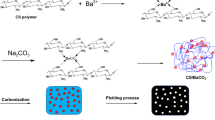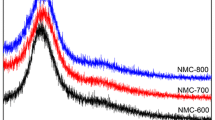Abstract
The ability of amidoximated mesoporous carbon (AO/CMK-3) by in situ polymerizing acrylonitrile onto the surface of mesoporous carbon (CMK-3) and reducing with hydroxylamine hydrochloride had been explored for the removal and recovery of uranium from aqueous solutions. The monolayer maximum capacity of AO/CMK-3 was improved from 69.20 of CMK-3 to 238.7 mg/g at 298 K. Calculated thermodynamic parameters showed endothermic property of the adsorption process, while kinetic parameters indicated that the interaction followed pseudo-second kinetic model. Selective separation of U(VI) from effluent by AO/CMK-3 was achieved.













Similar content being viewed by others
References
Barkat M, Nibou D, Amokrane S, Chegrouche S, Mellah A (2015) U(VI) adsorption on synthesized 4A and P1 zeolites: equlibrium, kinetic, and thermodynamic studies. C R Chim 18:261–269
Nassab HR, Souri A, Javadian A, Amini MK (2015) A novel mercury-free strip** voltammetric sensor for uranium based on electropolymerized N-phenylanthranilic acid film electrode. Sensor Actuators B-Chem 215:360–367
Donia AM, Atia AM, Ewais EMM, El-Sherif AM, Abd El-Magied MO (2009) Removal of uranium(VI) from aqueous solutions using glycidyl methacrylate chelating resins. Hydrometallurgy 95:183–189
Preetha CR, Gladis JM, Rao TP (2006) Removal of toxic uranium from synthetic nuclear power reactor effluents using uranyl ion imprinted polymer particles. Environ Sci Technol 40(9):3070–3074
Hu G, Li J, Hou H (2015) A combination of solvent extraction and freeze thaw for oil recovery from petroleum refinery wastewater treatment pond sludge. J Hazard Mater 283:832–840
Wei F, Cao C, Huang P, Song W (2015) A new ion exchange adsorption mechanism between carbonate groups and fluoride ions of basic aluminum carbonate nanospheres. Rsc Adv 5:13256–13260
Rao TP, Metilda P, Gladis JM (2006) Preconcentration techniques for uranium(VI) and thorium(IV) prior to analytical determination—an overview. Talanta 68:1047–1064
Coleman SJ, Coronado PR, Maxwell RS, Reynolds JG (2003) Granulated activated carbon modified with hydrophobic silica aerogel-potential composite materials for the removal of uranium from aqueous solutions. Environ Sci Technol 37:2286–2290
Vasylenko AI, Tokarchuk MV, Jurga S (2015) Effect of a vacancy in single-walled carbon nanotubes on He and NO adsorption. J Phys Chem C 119:5113–5116
Shao D, Jiang Z, Wang X, Li J, Meng Y (2009) Plasma induced grafting carboxymethyl cellulose on multiwalled carbon nanotubes for the removal of UO2 2+ from aqueous solution. J Phys Chem B 113:860–864
Ma X, Zhang F, Wei L (2015) Effect of wood charcoal contents on the adsorption property, structure and morphology of mesoporous activated carbon fibers derived from wood liquefaction process. J Mater Sci 50:1908–1914
Ryoo R, Joo SH, Jun S (1999) Synthesis of highly order carbon molecular sieves via template-mediated structural transformation. J Phys Chem B 103(37):7743–7746
Lee JS, Joo SH, Ryoo R (2002) Synthesis of mesoporous silicas of controlled pore wall thickness and their replication to ordered nanoporous carbons with various pore diameters. J Am Chem Soc 124(7):1156–1157
Tian G, Geng J, ** Y, Wang C, Chen Z, Wang H, Zhao Y, Li S (2011) Sorption of uranium(VI) using oxime-grafted ordered mesoporous carbon CMK-5. J Hazard Mater 190:442–450
Zhao Y, Liu C, Feng M, Chen Z, Tian G, Wang L, Huang J, Li S (2010) Solid phase extraction of uranium (VI) onto benzoylthiourea-anchored activated carbon. J Hazard Mater 176:119–124
Lu AH, Schüth F (2006) Nanocasting: a versatile strategy for creating nanostructured porous materials. Adv Mater 18:1793–1805
Darmstadt H, Roy C, Kaliaguine S, Kim TW, Ryoo R (2003) Surface and pore structures of CMK-5 ordered mesoporous carbons by adsorption and surface spectroscopy. Chem Mater 15:3300–3307
Kruk M, Jaroniec M, Kim TW, Ryoo R (2003) Synthesis and characterization of hexagonally ordered carbon nanopipes. Chem Mater 15:2815–2823
Wang Y, Zhang Z, Liu Y, Cao X, Li Q (2012) Adsorption of U(VI) from aqueous solution by the carboxyl-mesoporous carbon. Chem Eng J 198:246–253
Sprynskyy M, Kowalkowski T, Tutu H (2015) Ionic liquid modified diatomite as a new effective adsorbent for uranium ions removal from aqueous solution. Colloid Surf B 465:159–167
Shao D, Hou G, Li J, Wen T, Ren X, Wang X (2014) PANI/GO as a super adsorbent for the selective adsorption of uranium(VI) Chem. Eng J 255:604–612
Wang X, Yuan L, Chai Z, Shi W (2012) Mesoporous silica SBA-15 functionalized with phosphonate and amino groups for uranium uptake. Sci China Chem 55:1705–1711
Liu Y, Cao X, Hua R, Wang Y, Pang C, Hua M, Li X (2011) Biosorption studies of uranium(VI) on cross-linked chitosan: isotherm, kinetic and thermodynamic aspects. J Radioanal Nucl Chem 290:231–239
Sabarudin A, Noguchi O, Oshima M, Higuchi K, Motomizu S (2007) Application of chitosan functionalized with 3,4-dihydroxy benzoic acid moiety for on-line preconcentration and determination of trace elements in water samples. Microchim Acta 159:341–348
Merdivan M, Düz MZ, Hamamci C (2001) Sorption behaviour of uranium(VI) with N, N-dibutyl- N’-benzoylthiourea Impregnated in Amberlite XAD-16. Talanta 55:639–645
Merdivan M, Seyhan S, Gok C (2006) Use of benzoylthiourea immobilized on silica gel for separation and preconcentration of uranium (VI). Microchim Acta 154:109–114
Zhang Z, Zhou Z, Cao X, Liu Y, **ong G, Liang P (2014) Removal of uranium(VI) from aqueous solutions by new phosphorus-containing carbon spheres synthesized via one-step hydrothermal carbonization of glucose in the presence of phosphoric acid. J Radioanal Nucl Chem 299:1479–1487
Horzum N, Shahwan T, Parlak O, Demir MM (2012) Synthesis of amidoximated polyacrylonitrile fibers and its application for sorption of aqueous uranyl ions under continuous flow. Chem Eng J 213:41–49
Das S, Pandey AK, Vasudevan T, Athawale AA, Manchanda VK (2009) Adsorptive preconcentration of uranium in hydrogels from seawater and aqueous solutions. Ind Eng Chem Res 48:6789–6796
Geng J, Ma L, Wang H, Liu J, Bai C, Li S (2012) Amidoxime-grafted hydrothermal carbon microspheres for highly selective separation of uranium. J Nanosci Nanotechnol 12:7354–7363
Pickett G (1945) Modification of the Brunauer-Emmett-Teller theory of multimolecular adsorption. J Am Chem Soc 67:1958–1962
Barrett E, Joyner L, Halenda P (1951) Study of pore size distribution by capillary absorption method. J Am Chem Soc 73:373–380
Bhatti TM, Mateen A, Amin M, Malik KA, Khalid AM (1991) Spectrophotometric determination of uranium(VI) in bacterial leach liquors using arsenazo-III. J Chem Technol Biot 52:331–341
Liu X, Liu H, Ma H, Cao C, Yu M, Wang Z, Deng B, Wang M, Li J (2012) Adsorption of the uranyl ions on an amidoxime-based polyethylene nonwoven fabric prepared by preirradiation-induced emulsion graft polymerization. Ind Eng Chem Res 51:15089–15095
Kruk M, Jaroniec M (2001) Gas adsorption characterization of ordered organic-inorganic nanocomposite materials. Chem Mater 13:3169–3183
Beck J, Vartuli J, Roth W, Leonowicz M, Kresge C, Schmitt K, Chu C, Olson D, Sheppard E (1992) A new family of mesoporous molecular sieves prepared with liquid crystal templates. J Am Chem Soc 114:10834–10843
Kresge C, Leonowicz M, Roth W, Vartuli J, Beck J (1992) Ordered mesoporous molecular sieves synthesized by a liquid-crystal template mechanism. Nature 359:710–712
Gupta VK, Rastogi A (2008) Biosorption of lead(II) from aqueous solutions by non-living algal biomass Oedogonium sp. and Nostoc sp.—A comparative study. Colloids Surf B 64:170–178
Barnett MO, Jardine PM, Brooks SC, Selim HM (2000) Adsorption and transport of uranium(VI) in subsurface media. Soil Sci Soc Am J 64:908–911
Zhao A, Uchiyama G, Asakura T (2005) The pH Effect on the uranium adsorption from seawater by a macroporous fibrous polymeric material containing amidoxime chelating functional group. React Funct Polym 63:143–153
Bektaş N, Ağım BA, Kara S (2004) Kinetic and equilibrium studies in removing lead ions from aqueous solutions by natural sepiolite. J Hazard Mater 112:115–122
Ho YS, McKay G (1998) Comparison of chemisorption kinetic models applied to pollutant removal on various sorbents. Process Saf Environ Prot 76:332–340
Arıca MY, Bayramoǧlu G, Yılmaz M, Bektaş S, Genç Ö (2004) Biosorption of Hg2+, Cd2+, and Zn2+ by Ca-alginate and immobilized wood-rotting fungus Funalia trogii. J Hazard Mater 109:191–199
Langmuir I (1918) The adsorption of gases on plane surfaces of glass, mica and plat-inum. J Am Chem Soc 40:1361–1403
Gerente C, Lee V, Cloirec PL, McKay G (2007) Application of chitosan for the removal of metals from wastewaters by adsorption—mechanisms and models review. Crit Rev Environ Sci Technol 37:41–127
Freundlich H (1906) Ueber dye adsorption in lösungen. Z Phys Chem 57:385–470
Anirudhan T, Divya L, Suchithra P (2009) Kinetic and equilibrium characterization of uranium(VI) adsorption onto carboxylate-functionalized poly(hydroxyethylmethacrylate)-grafted lignocellulosics. J Environ Manage 90:549–560
Kilislioglu A, Bilgin B (2003) Thermodynamic and kinetic investigations of uranium adsorption on amberlite IR-118H resin. Appl Radiat Isot 58:155–160
Gürboğa G, Tel H (2005) Preparation of TiO2–SiO2 mixed gel spheres for strontium adsorption. J Hazard Mater 120:135–142
Singh DK, Mishra S (2009) Synthesis and characterization of UO2 2+-ion imprinted polymer for selective extraction of UO2 2+. Anal Chim Acta 644:42–47
Acknowledgments
We gratefully acknowledge the financial support provided by the National Natural Science Foundation of China (Grant Nos. 21301028, 21201033, 11475044, 41461070), National Basic Research Program of China (NO. 2014CB460604), Natural Science Foundation of Jiangxi Province (Grant No. 20132BAB203027), the Project of the Jiangxi Provincial Department of Education (Grant No. GJJ13452, GJJ14472), the Jiangxi province science and technology support program (20141BBG70001), and the Jiangxi province science and technology innovation team program (20142BCB24006).
Author information
Authors and Affiliations
Rights and permissions
About this article
Cite this article
Cheng, Zp., Liu, Yh., **ong, Gx. et al. Preparation of amidoximated polymer composite based on CMK-3 for selective separation of uranium from aqueous solutions. J Radioanal Nucl Chem 306, 365–375 (2015). https://doi.org/10.1007/s10967-015-4215-1
Received:
Published:
Issue Date:
DOI: https://doi.org/10.1007/s10967-015-4215-1




